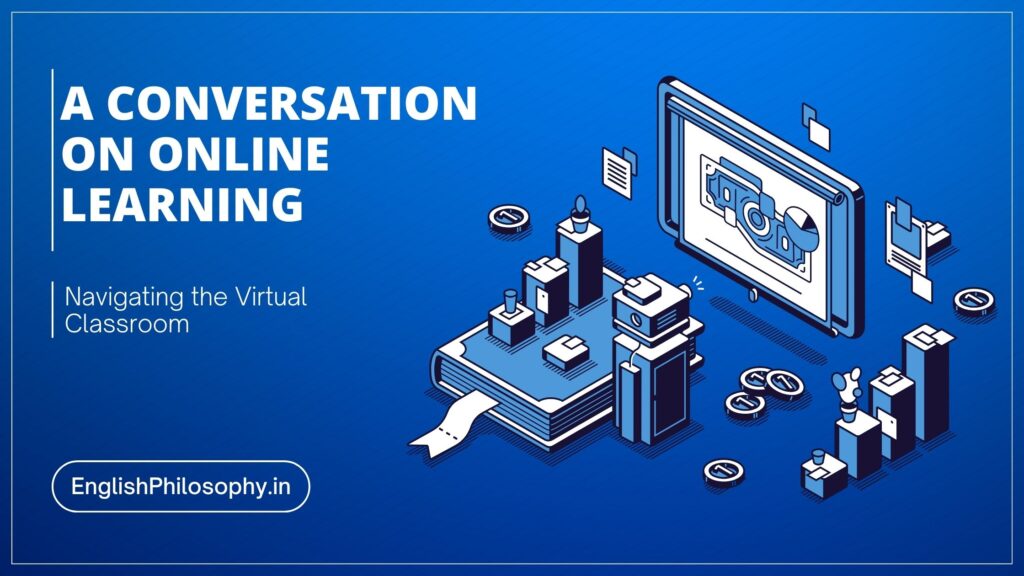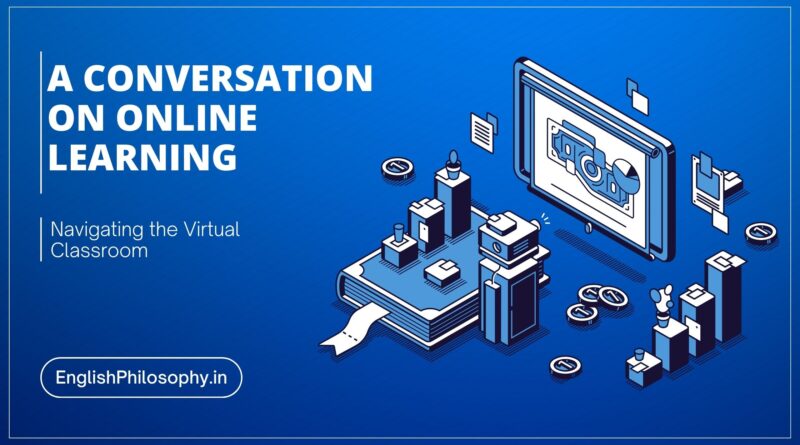A Conversation on Online Learning : Navigating the Virtual Classroom
Introduction: Virtual Classroom
In recent times, the shift to virtual classes has transformed the landscape of education, creating a dynamic learning environment that students and educators are adapting to with varying degrees of ease. In this conversation, we’ll explore the nuances of virtual classes, discussing the challenges, advantages, and the impact of technology on education. Let’s read A Conversation on Online Learning.

Conversation : John and Emma on Online Learning
John: Hey, Emma! How’s the transition to virtual classes treating you?
Emma: Hi, John! It’s been quite a journey. I’m adjusting, but there are definitely some challenges. How about you?
John: Same here. The whole idea of attending classes from my living room is still sinking in. But let’s dive into it. What challenges have you faced with virtual classes?
Emma: Well, one big challenge is the lack of direct interaction with teachers. It’s not as easy to ask questions or get instant feedback. And the tech issues, oh my! Sometimes the platform crashes right in the middle of a lecture.
John: I feel you on that. It’s frustrating when you’re in the flow of learning, and suddenly, technology decides to play tricks. But you know, I find the flexibility quite appealing. I can review lectures at my own pace.
Emma: That’s true. Flexibility is a big plus. And the recordings help when you miss a class. But, honestly, I miss the real classroom vibe. It’s just not the same.
John: Absolutely. The social aspect is a big miss. No more chats before class, no group projects in person. It’s all a bit impersonal.
Emma: And let’s not forget the struggle to stay focused. At home, there are so many distractions. It’s hard to resist the temptation of just checking your phone or grabbing a snack.
John: Guilty as charged! Maintaining discipline is crucial. But, you know, some of the apps and tools they’re introducing are quite helpful. Have you tried any?
Emma: I’ve started using some productivity apps. They help with time management, reminders for assignments, and even focus timers. It’s a game-changer.
John: Nice move! I’ve been experimenting with virtual study groups. It’s not the same as being physically present, but it’s better than going it alone.
Emma: That’s a cool idea. I miss the camaraderie of study groups. But hey, let’s switch gears. What about teachers adapting to this virtual shift?
John: It’s a learning curve for them too. Some are tech-savvy, while others are still figuring it out. But I appreciate the effort. They’re experimenting with different teaching methods to keep us engaged.
Emma: Absolutely. I’ve noticed that too. Some teachers are using interactive tools, quizzes, and breakout sessions. It adds an element of fun to the virtual classroom.
John: Totally agree. Now, I’ve read about “hybrid learning” becoming a trend. It’s a mix of in-person and virtual classes. What are your thoughts on that?
Emma: Hybrid learning could be the best of both worlds. You get the benefits of online flexibility and the in-person social interaction. It’s a balanced approach.
John: True, and it might be the future of education. I’ve heard the term “blended learning” too, where educators combine traditional methods with online elements. It’s like a fusion cuisine of education!
Emma: Haha, love the analogy! Blended learning sounds interesting. It could cater to different learning styles. So, what’s your take on the long-term impact of virtual classes?
John: Well, it’s definitely reshaping the way we learn. I think it’s forcing us to become more self-disciplined and tech-savvy, skills that are valuable in any field.
Emma: Agreed. And it’s breaking down geographical barriers. You can attend a lecture from anywhere in the world. That’s pretty revolutionary.
John: Absolutely! The democratization of education is a powerful concept. It’s making quality education more accessible.
Emma: But, we can’t ignore the digital divide. Not everyone has access to high-speed internet or devices. That’s an issue that needs attention.
John: You’re right. Bridging the digital gap should be a priority. No student should be left behind.
Conclusion: Navigating the Virtual Classroom
In this evolving landscape of virtual classes, students like John and Emma are navigating through challenges while embracing the advantages. As technology continues to shape education, the conversation around virtual classes remains dynamic, reflecting the resilience and adaptability of students and educators alike.
Whether it’s the flexibility of online learning, the challenges of staying focused, or the innovative approaches of teachers, the virtual classroom is undeniably a space where trends and traditions are merging to define the future of education.




